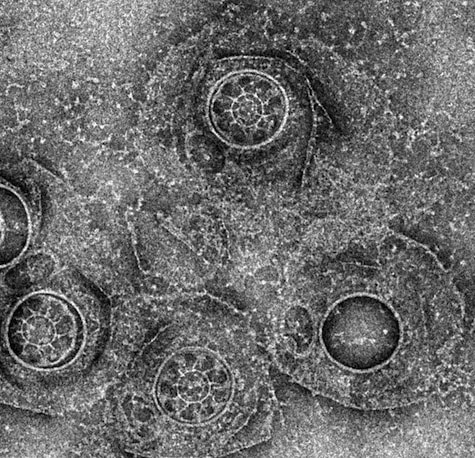 Evolution
Evolution
 Intelligent Design
Intelligent Design
Machine Within a Machine: The Ciliary Partitioning System

Cilia are found in living organisms from microbes to man. Microbes use them for swimming. In the human body, they play multiple important roles. A news release from Lawrence Berkeley National Lab explains:
Just about every cell in your body contains microscopic organelles called cilia. Primary cilia act like antennas, detecting and relaying molecular signals from a cell’s external environment. Motile cilia paddle together in a single direction, like oars on a rowboat, either moving a cell along or regulating the flow of fluids around the cell. Properly functioning cilia are critical to good health. (Emphasis added.)
During embryo development, rows of motile cilia create fluid currents to direct cells to their destinations. In the airway, rows of cilia conduct dust from the trachea to the mouth where they can be coughed out. Non-motile cilia have many roles in signal transduction. Diseases of the cilia, or “ciliopathies,” can have devastating effects.
In his book Darwin’s Black Box (1996), Michael Behe used the cilium as an example of his then new term “irreducible complexity.” By the time Behe wrote The Edge of Evolution (2007), so much more had been learned about cilia that he characterized the structure as exemplifying “irreducible complexity squared.” Now, another discovery might raise the exponent another notch.
The press release from Berkeley Lab, “How Cilia Get Organized,” points out another wonder of cilia, the way the ingredients are partitioned off from the rest of the cell for construction. A builder knows not to throw his materials at a property in a pile. They have to be arranged in an orderly way for efficient assembly at the right place and time. The growing cilium has a neat way to “get organized,” called the “cilia partitioning system.”
“This is the first identification or certainly the first isolation of a physical structure that could serve as the partitioning system for cilia,” says Ken Downing, a biophysicist with Berkeley Lab’s Life Sciences Division who led this research. “While many suspected that such a system existed, nobody had found it nor seemed to have much of an idea as to how it might work.“
The search for a design paid off. Researchers identified a structure at the base of the cilium that organizes the parts to create the axoneme — a membrane-bounded “tail” enveloping nine microtubules arranged in a ring, where “intraflagellar transport” (described in Behe’s second book) can take place. Here’s what the team found:
Downing and his colleagues found a plate-shaped structure at the ciliary base that potentially serves as a cytosolic “ciliary pore complex.” Featuring nine pores through which the microtubules pass, this complex forms tunnels for the movement of proteins from the cytoplasm of the cell into the cilia. The researchers also found a detergent-resistant membrane region well-suited to serve as a diffusion barrier, plus a ring complex that connects the ciliary pore complex to the membrane diffusion barrier.
All these parts not only have to be at the right place at the right time, they must have the right shapes, sizes, and relative positions to work. If one of the nine pores or tunnels is out of alignment, or is too tight, no cilium will be built. If the diffusion barrier did not have the right properties, the parts would either be blocked from delivery, or stray molecules could interfere. If the ring complex were missing, it could not connect the ciliary pore complex to the membrane diffusion barrier.
All these precision parts are necessary just to begin building the cilium, never mind actually building it and making it operate. This new “ciliary pore complex,” part of a “ciliary partitioning system,” is a wonder of design in and of itself. As part of a larger system of interrelated and interdependent parts, it might warrant the description, “irreducible complexity cubed.”
Image credit: Berkeley Lab.
